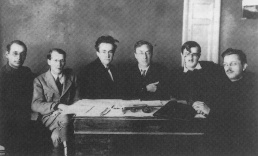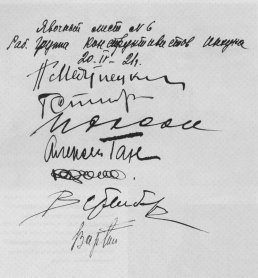Difference between revisions of "INKhUK"
| Line 36: | Line 36: | ||
** "Programme of the Working Group of Constructivist of Inkhuk", in S.O. Khan-Magomedov, ''Rodchenko: The Complete Work'', London, 1986, p 290. {{en}} | ** "Programme of the Working Group of Constructivist of Inkhuk", in S.O. Khan-Magomedov, ''Rodchenko: The Complete Work'', London, 1986, p 290. {{en}} | ||
* {{a|Constr1922}} "Front khudozhestvennogo truda. Materialy k Vserossiiskoi konferentsii levykh v iskusstve. Konstruktivisty. Pervaya programma rabochey gruppy konstruktivistov" [Фронт художественного труда. Материалы к Всероссийской конференции левых в искусстве. Конструктивисты. Первая программа рабочей группы конструктивистов], ''Ermitazh'', Moscow, Aug 1922, pp 3-4. The only printed Russian version of their program that appeared in the 1920s. The introduction states "On 13 December 1920, the First Working Group of Constructivists was formed" (p. 3) and cites Rodchenko, Stepanova, and Gan as the founders. {{ru}} | * {{a|Constr1922}} "Front khudozhestvennogo truda. Materialy k Vserossiiskoi konferentsii levykh v iskusstve. Konstruktivisty. Pervaya programma rabochey gruppy konstruktivistov" [Фронт художественного труда. Материалы к Всероссийской конференции левых в искусстве. Конструктивисты. Первая программа рабочей группы конструктивистов], ''Ermitazh'', Moscow, Aug 1922, pp 3-4. The only printed Russian version of their program that appeared in the 1920s. The introduction states "On 13 December 1920, the First Working Group of Constructivists was formed" (p. 3) and cites Rodchenko, Stepanova, and Gan as the founders. {{ru}} | ||
| + | ** "A konstruktivisták csoportjának programja", ''Egység'' 2:5, Vienna, May 1922. {{hu}} | ||
** "Program of the Constructivist Working Group of INKhUK", in ''Art Into Life: Russian Constructivism, 1914-1932'', eds. Richard Andrews and Milena Kalinovska, New York: Rizzoli, 1990, pp 67f. {{en}} | ** "Program of the Constructivist Working Group of INKhUK", in ''Art Into Life: Russian Constructivism, 1914-1932'', eds. Richard Andrews and Milena Kalinovska, New York: Rizzoli, 1990, pp 67f. {{en}} | ||
** [http://archive.org/stream/ArtInTheory/AIT#page/n170/mode/1up Programme of the First Working Group of Constructivists"], trans. Christina Lodder, in ''Art in Theory'', 1992, pp 317-318. {{en}} | ** [http://archive.org/stream/ArtInTheory/AIT#page/n170/mode/1up Programme of the First Working Group of Constructivists"], trans. Christina Lodder, in ''Art in Theory'', 1992, pp 317-318. {{en}} | ||
Revision as of 22:52, 9 August 2015
Institut Khudozhestvennoi Kulturi (INKhUK) (Institute of Artistic Culture, 1920–24) was an artistic organization, a creative society of painters, graphic artists, sculptors, architects, and art scholars. The institute was set up in Moscow in March 1920 as a section of IZO Narkompros (the Department of Visual Arts of the People’s Commissariat for Education) to determine the course of artistic experiment in post-Revolutionary Russia. INKhUK had its own regulations and program.
Contents
Organisation
INKhUK repeatedly changed its general orientation, organisational structure, membership, and leadership. It maintained close ties with a number of other creative, educational, and research organizations, such as the VkHUTEMAS and LEF. INKhUK was a discussion club and theoretical center.
Its first director was Kandinsky. Further sections were formed in Petrograd under Tatlin and in Vitebsk under Malevich. The program of INKhUK was initially influenced by the leftist trends in art (for example, abstract art). In accordance with Kandinsky’s program of 1920, artists affiliated with INKhUK studied the formal devices in various types of art (for example, music, painting, and sculpture) and the uniqueness of their influence upon the viewer.
Kandinsky's ideals soon proved uncongenial to the more widespread desire to create an art suitable for a Communist utopia. After Kandinsky was voted out of office in the late 1920, two different programmes emerged. ‘Laboratory art’ involved a rationalizing, analytical approach often using traditional artistic materials (such as paint and canvas); ‘production art’ placed the emphasis more on designers and craftsmen working for machine production, striving to apply the results of their artistic experiments to daily practical activities. The latter group proved the more influential of the two, contributing to the development of Constructivism. [1]
In 1921, the LEF program was developed in INKhUK, and attention was focused upon finding a theoretical solution to the problems of constructivism and production art. Under the auspices of INKhUK, experimental work in artistic design was conducted, and educational programs were organized at VkHUTEMAS.
Among the artists active in INKhUK were B. I. Arvatov, A. V. Babichev, Brik, Lissitzky, Popova, Rodchenko, and Stepanova.
Architecture
During their affiliation with INKhUK the leaders of the two most important schools of Soviet architecture in the 1920s, Nikolai Ladovsky and Alexander Vesnin, developed their views on art. In addition, the first working groups were organized in INKhUK, which later became the Association of New Architects and the Organization of Contemporary Architects.
In 1923, an institute similar in character was organized in Leningrad, the State Institute of Artistic Culture.
Constructivism
Between 1 January and 22 April 1921 INKhUK hosted a series of nine meetings of the Working Group of Objective Analysis to discuss and define the distinction between construction and composition.
Parallel and in reaction to these the First Working Group of Constructivists [Рабочая группа конструктивистов ИНХУКа] had formed with its first official meeting on 18 March 1921[1]. The group included five creators of "spatial constructions"--Rodchenko, Ioganson, Medunetsky, Stenberg brothers--joined by Stepanova and, from outside the Inkhuk, the cultural agitator Gan. The five sculptors participated in the now renowned Second Spring Exhibition of OBMOKhU in May-June 1921.
Dispersal
In 1923 the work in the Institute began to stagnate. During 1923 and 1924 the institute experienced a lack of public support and gradually disintegrated.
After its closure, the archive of INKhUK passed to a sculptor who played a vital role in its daily operations--Aleksei Babichev--from whose widow, Natal'ia Babicheva, it was eventually acquired by the Greco-Russian collector George Costakis (Georgii Kostaki) before his emigration to Greece in 1978, where it is now preserved in the State Museum of Contemporary Art in Thessaloniki.[2]
Documents and publications
- of the First Working Group of Constructivists
- "Report No. 1. The Assembly for the Organisation of the Working Group of Constructivists of Inkhuk" [18 Mar 1921], trans. Huw Evans, in S.O. Khan-Magomedov, Rodchenko: The Complete Work, London, 1986, pp 289-290. (English)
- Aleksei Gan, "Report No. 2. Meeting of the Plenum of the Working Group of Constructivists of Inkhuk" [28 Mar 1921], trans. Huw Evans, in S.O. Khan-Magomedov, Rodchenko: The Complete Work, London, 1986, p 290. (English)
- "Programma uchebnoi podgruppy konstruktivistov INKhUKa" [Программа учебной подгруппы конструктивистов ИНХУКа] [1 Apr 1921], private archive, Moscow. Draft program approved by the group; with few alterations published in Aug 1922 and further elaborated in Gan 1922. (Russian)
- "Programme of the Working Group of Constructivist of Inkhuk", in S.O. Khan-Magomedov, Rodchenko: The Complete Work, London, 1986, p 290. (English)
- "Front khudozhestvennogo truda. Materialy k Vserossiiskoi konferentsii levykh v iskusstve. Konstruktivisty. Pervaya programma rabochey gruppy konstruktivistov" [Фронт художественного труда. Материалы к Всероссийской конференции левых в искусстве. Конструктивисты. Первая программа рабочей группы конструктивистов], Ermitazh, Moscow, Aug 1922, pp 3-4. The only printed Russian version of their program that appeared in the 1920s. The introduction states "On 13 December 1920, the First Working Group of Constructivists was formed" (p. 3) and cites Rodchenko, Stepanova, and Gan as the founders. (Russian)
- "A konstruktivisták csoportjának programja", Egység 2:5, Vienna, May 1922. (Hungarian)
- "Program of the Constructivist Working Group of INKhUK", in Art Into Life: Russian Constructivism, 1914-1932, eds. Richard Andrews and Milena Kalinovska, New York: Rizzoli, 1990, pp 67f. (English)
- Programme of the First Working Group of Constructivists", trans. Christina Lodder, in Art in Theory, 1992, pp 317-318. (English)
Notes
- ↑ Khan-Magomedov 1986: 289. Khan-Magomedov 1996 dates their first organisational meeting to 23 February.
- ↑ Gough 2005: 25.
Literature
- on INKhUK
- Christina Lodder, "INKhUK: The Institute of Artistic Culture", in Lodder, Russian Constructivism, Yale University Press, 1983, pp 78-83. (English)
- S.O. Khan-Magomedov, Rodchenko: The Complete Work, London: Thames and Hudson, 1986, pp 55ff. (English)
- on Construction/composition debate
- Maria Gough, "Differentiating Composition and Construction", in Gough, The Artist as Producer: Russian Constructivism in Revolution, University of California Press, 2005, pp 39-56. (English)
- Christina Lodder, "The Composition-Construction Debate", in Lodder, Russian Constructivism, Yale University Press, 1983, pp 83-94. (English)
- on the Working Group of Constructivists
- Christina Lodder, "The First Working Group of Constructivists", in Lodder, Russian Constructivism, Yale University Press, 1983, pp 94-98. (English)
- Kristin Romberg, "Gan's Constructivism, 1921: The First Working Group of Constructivists", ch 2 in Romberg, Aleksei Gan's Constructivism, 1917-1928, New York: Columbia University, 2010, pp 95-173. Ph.D. Dissertation. (English)

